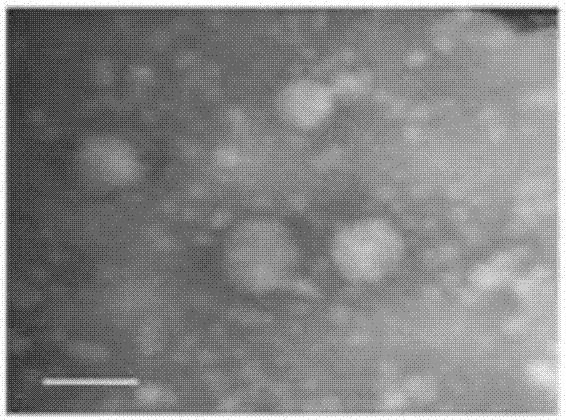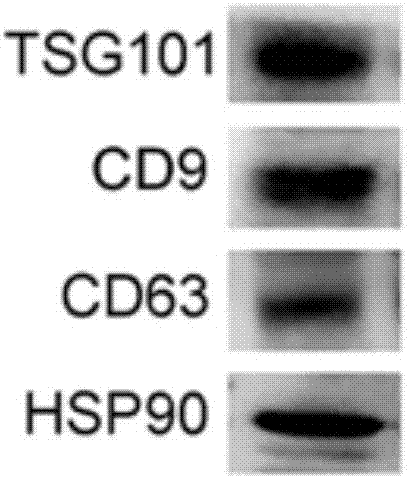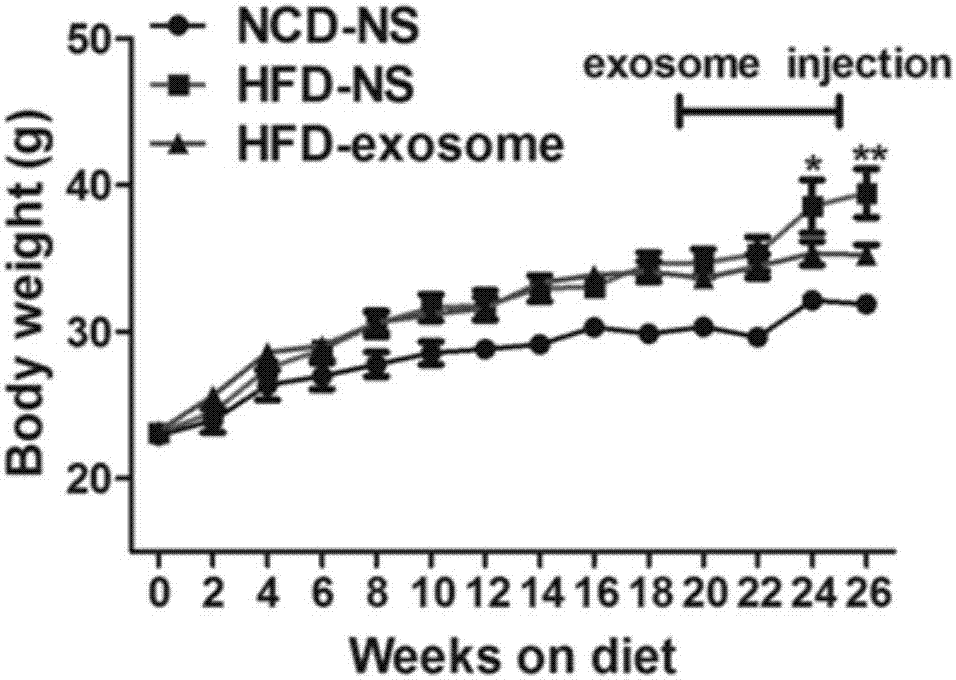Application of adipose-derived mesenchymal stem cell exosome in preparation of medicines for obesity treatment
A fat-derived, stem cell technology, applied in the field of biomedicine
- Summary
- Abstract
- Description
- Claims
- Application Information
AI Technical Summary
Problems solved by technology
Method used
Image
Examples
Embodiment 1
[0044] Embodiment 1: the extraction and separation of ADSC
[0045] (1) Isolation of adipose tissue: select 10-12 weeks old C57BL / 6 male mice, kill the mice by neck dislocation, open the abdominal cavity, peel off the fat in the epididymis, remove the blood vessels as much as possible, weigh the weight of the fat, and immerse it in PBS on ice placed on.
[0046] (2) Preparation of digestive juice: According to the weight of fat, 3ml of KRB buffer solution and 6mg of type Ⅰ collagenase are required for each gram of fat.
[0047](3) Digestion of adipose tissue: Cut the stripped adipose tissue mechanically, add it to the prepared digestive solution, mix well, place it in a shaker at 37°C for 45 minutes, centrifuge at 2000rpm for 5 minutes, carefully remove the cells at the bottom and place Place on ice in KRB without enzyme.
[0048] (4) Filtration: filter the cell suspension with a copper mesh with a pore size of 100 μm, centrifuge the filtered suspension at 2000 rpm for 5 min...
Embodiment 2
[0052] Example 2: Extraction and identification of ADSC-derived exosomes
[0053] ADSCs were cultured with exosome-free 10% fetal bovine serum DMEM medium (containing bFGF). Take the fourth-generation ADSC cell culture supernatant, filter it with a 0.22μm sterile filter, centrifuge at 5000g in a 100K concentrated centrifuge tube at 4°C for 30 minutes, take the concentrated solution from the upper chamber into a new sterile 15ml centrifuge tube, and add Exoquick-TCTM For the exosome extraction reagent, place at 4°C overnight, centrifuge at 5000g, 4°C for 30 minutes, discard the supernatant, resuspend the pellet with sterile PBS and aliquot, freeze at -80°C for storage.
[0054] The size and shape of the extracted exosomes were detected by transmission electron microscopy, and the results were as follows: figure 1 Shown; Exosome markers TSG101, CD9, CD63, HSP90 were detected by western-blot method, and further identified, the results are as follows figure 2 shown.
Embodiment 3
[0055] Example 3: Effect of ADSC-derived exosomes on diet-induced high-fat obesity model
[0056] (1) Establishment of diet-induced hyperlipidemia model and exosome intervention
[0057] Seven-week-old C57BL / 6 male mice were used to establish obesity models. After a week of pre-high-fat diet adaptation, they were fed a high-fat diet (HFD) (containing 60% cal), and fed a normal diet (NCD) as a control group. After 12-20 weeks of high fat, the exosomes prepared in Example 2 were injected intraperitoneally (30 μg / mouse, injected once every 3 days, and continuously injected for 6-8 weeks), which was the HFD-exosome group; the intraperitoneal injection of normal saline group was The control group, namely HFD-NS. NCD-NS was observed in mice fed normal diet and injected with normal saline intraperitoneally.
[0058] (2) Detection of body weight changes in mice
[0059] During the period of high-fat feeding and exosome intervention, the body weight of the mice was detected every w...
PUM
| Property | Measurement | Unit |
|---|---|---|
| diameter | aaaaa | aaaaa |
Abstract
Description
Claims
Application Information
 Login to View More
Login to View More - R&D
- Intellectual Property
- Life Sciences
- Materials
- Tech Scout
- Unparalleled Data Quality
- Higher Quality Content
- 60% Fewer Hallucinations
Browse by: Latest US Patents, China's latest patents, Technical Efficacy Thesaurus, Application Domain, Technology Topic, Popular Technical Reports.
© 2025 PatSnap. All rights reserved.Legal|Privacy policy|Modern Slavery Act Transparency Statement|Sitemap|About US| Contact US: help@patsnap.com



